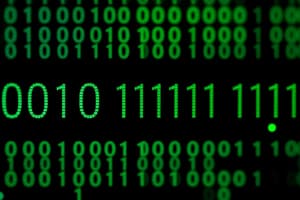Podcast
Questions and Answers
What is the binary representation of the decimal number 10?
What is the binary representation of the decimal number 10?
- 00001110
- 00001010 (correct)
- 00000100
- 00010010
What consists of the digits 0 and 1 in networking?
What consists of the digits 0 and 1 in networking?
- Hexadecimal
- Decimal
- Octal
- Binary (correct)
How many bits are in an IPv4 address?
How many bits are in an IPv4 address?
- 16 bits
- 24 bits
- 64 bits
- 32 bits (correct)
In dotted decimal notation, how is an IPv4 address presented?
In dotted decimal notation, how is an IPv4 address presented?
What is the decimal equivalent of the binary number 11000000?
What is the decimal equivalent of the binary number 11000000?
What are the sections of a binary IPv4 address called?
What are the sections of a binary IPv4 address called?
What does each bit in a binary number represent in terms of value?
What does each bit in a binary number represent in terms of value?
Which is the correct representation of the decimal number 192 in binary?
Which is the correct representation of the decimal number 192 in binary?
How many bits does an IPv6 address contain?
How many bits does an IPv6 address contain?
What is each group of four hexadecimal digits in an IPv6 address called?
What is each group of four hexadecimal digits in an IPv6 address called?
Which numbering system consists of only 0 and 1?
Which numbering system consists of only 0 and 1?
In terms of representation, what is unique about an IPv6 address compared to an IPv4 address?
In terms of representation, what is unique about an IPv6 address compared to an IPv4 address?
What is zero compression in IPv6 addressing?
What is zero compression in IPv6 addressing?
What is the preferred format for writing an IPv6 address?
What is the preferred format for writing an IPv6 address?
Which of the following correctly describes a hextet in IPv6?
Which of the following correctly describes a hextet in IPv6?
What is the first step in converting a decimal number to hexadecimal?
What is the first step in converting a decimal number to hexadecimal?
What is the equivalent decimal value of the hexadecimal number D2?
What is the equivalent decimal value of the hexadecimal number D2?
How many bits are there in an IPv4 address?
How many bits are there in an IPv4 address?
What character is used to separate each octet in an IPv4 address?
What character is used to separate each octet in an IPv4 address?
What is the binary equivalent of the decimal number 168?
What is the binary equivalent of the decimal number 168?
Flashcards are hidden until you start studying
Study Notes
Binary Representation
- Each octet in binary consists of 8 bits.
- The decimal number 192 is represented as 11000000 in binary.
Subnetting and Routing
- Converting IPv4 addresses to binary is vital for subnetting and routing.
- Understanding the network and host portions of the address aids in network configuration and troubleshooting.
Positional Notation
- The binary system employs positional notation where each bit signifies a power of two.
- The rightmost bit corresponds to 2^0, with subsequent bits representing increasing powers of two.
Ease of Calculation
- While decimal notation is more user-friendly for humans, computers utilize binary.
- Converting to binary streamlines calculations essential for subnetting and determining network ranges.
IPv6 Hexadecimal Structure
- An IPv6 address spans 128 bits, depicted as eight groups of four hexadecimal digits, separated by colons.
- Each group of hexadecimal digits (hextet) represents 16 bits.
Hexadecimal Digits
- Hexadecimal uses digits 0-9 and letters a-f, with no case sensitivity in representation.
Hextets
- Informally, a group of four hexadecimal digits is referenced as a hextet, analogous to octets in IPv4.
Zero Compression
- IPv6 addresses can be abbreviated by using zero compression; consecutive zero groups may be replaced by a double colon (::), usable only once per address.
Binary Number System
- The binary system consists of bits (0 and 1), contrasting with the decimal system (digits 0-9).
- Hexadecimal effectively represents binary values, essential for IP Version 6 addresses and Ethernet MAC addresses.
Converting Decimal to Hexadecimal
- Convert a decimal number to an 8-bit binary string.
- Group binary strings into four bits, convert to hexadecimal.
- Example: Decimal 168 converts to hex A8 (binary 10101000).
Converting Hexadecimal to Decimal
- Convert hex to 4-bit binary strings.
- Form 8-bit binary groupings; convert them into decimal.
- Example: Hex D2 is equivalent to decimal 210 (binary 11010010).
IPv4 Address Structure
- An IPv4 address is a 32-bit number divided into four 8-bit groups (octets), separated by dots (e.g., 192.168.1.1).
- Each octet can be converted to binary individually.
Binary Usage
- IPv4 addresses are conveyed in binary form to identify devices, comprising 32 bits divided into octets.
- Human management of binary is challenging; thus, dotted decimal notation is commonly utilized for ease.
Conversion Techniques
- Understanding binary to decimal conversion requires a grasp of positional notation.
- For example: IPv4 address 192.168.10.11 can be systematically converted using positional values or simpler calculations for smaller numbers.
Practice
- Familiarity with binary and decimal conversions will improve with practice, facilitating a deeper understanding of network addressing.
Studying That Suits You
Use AI to generate personalized quizzes and flashcards to suit your learning preferences.




